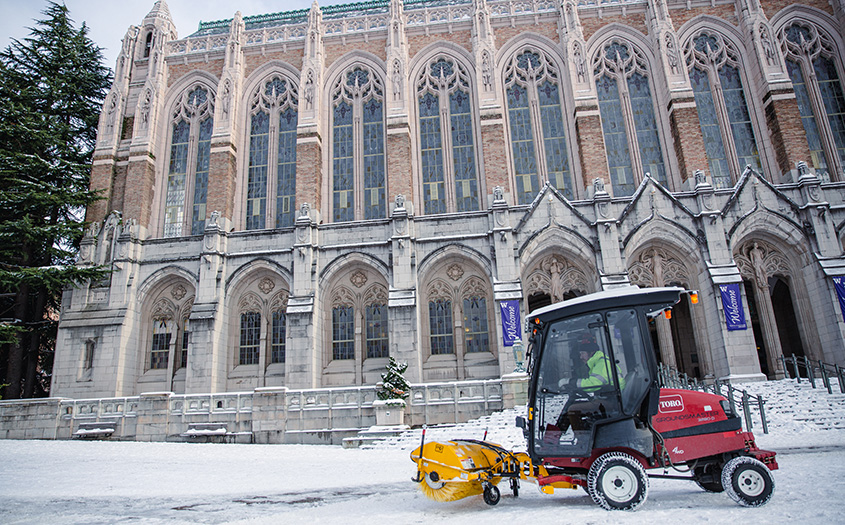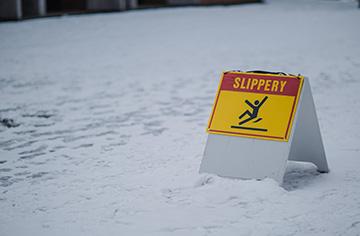Working snow patrol

A UW Facilities staff member clears snow in front of Suzzallo Library in December 2021. April Hong/University of Washington
Don Satko has lived in the Puget Sound region all his life. He doesn’t remember there being many snowstorms growing up in the 1970s, but “now it seems like it's every year,” he said.
As a heavy equipment operator with UW Facilities, Satko sees the impact of snowier winters up close. He runs the snowplows, de-icer truck and other equipment used to keep the Seattle campus safe.
“The past couple years, we would plow a road, go around campus, and it’s like we've never been,” he said. “Sometimes it just comes down so fast that just trying to keep up is hard.”
Satko is part of a snow response effort that spans UW Facilities: Gardeners shovel pathways and stairways leading to building entrances, which are swept by custodians. Transportation Services staff keep parking lots and garages accessible. Staff across the department step up to help when needed.
Some members of the team stay in a nearby hotel when there’s a snowstorm. Many of them live farther north or south, and the hotel stay allows them to safely get to campus.
You might think that sounds luxurious, but there isn’t much open when it snows. The only options for food might be using a microwave or eating in the residence halls, which Satko works to make sure are accessible so that students are fed and safe. Another focus is keeping the areas around UW Medical Center and its helipad cleared of snow and ice.
Satko and the team base their schedule on when the snowfall begins, but sometimes start their work as early as 2 a.m. That gives them a special view that few experience.
"What's nice is the campus is just quiet,” said Satko. “We're here early in the morning, and yeah, it's a beautiful campus. You cover it with snow and the lights, and it’s a nice, quiet time.”
They also get to experience the wonder of the season through the eyes of the students, some of whom have never seen snow before. Other students treat campus as an unofficial ski resort: sledding, cross-country skiing, snowboarding and more.
But the fun doesn’t come without its hazards.
“We try to keep our windows up on the snowplows,” he said. “You never know when the snowballs are coming. But it's a good time on campus, and everyone is enjoying it.”
Satko and the UW Facilities team are working to keep the University safe and operational, but it’s important that we each look out for our own safety, as conditions may change suddenly.
Stay informed
Stay informed
Sign up for UW Alerts to stay informed about disruptions to normal University operations. Changes could include canceling classes, closing office or switching to virtual operations. Campus Community Safety has more information about when and how weather-related decisions are made.
UW Emergency Management has information related to winter storm preparedness, including tips and a list of resources. The City of Seattle Department of Transportation has a list of winter safety tips and resources as well.
If you are coming to campus, an important tool you can use is the Snow Removal Progress map, where you can find out the status of roads, sidewalks and parking lots. Understanding where snow has been removed from different parts of campus can ease frustration and help you stay safe. Please note that while the map is updated in real time by staff doing the work of snow removal, snow conditions are ever-changing so the map should be used as guidance, not a guarantee.
Use caution walking on campus
Use caution walking on campus
Walkways and stairwells can become slippery, so give yourself extra time to get where you’re going. Observe boundaries and restricted areas. Do not attempt to cross areas of campus where caution tape, barricades or signage have been posted as these areas may be notably slippery and dangerous.
Follow these tips from UW Environmental Health & Safety to avoid slips, trips and falls:
- Wear footwear with good traction and insulation. Avoid boots and shoes with smooth soles and heels. Consider using snow/ice grippers (such as Yaktrax) for your shoes.
- Assume that wet, dark pavement areas may be slippery or icy.
- Take shorter steps and walk at a slower pace.
- Hold onto handrails when using stairs.
- Do not do anything distracting while walking, such as using a phone.
- Take special care when stepping in and out of vehicles.
- Use extreme caution when stepping off curbs and walking up steep slopes.
- Keep your hands free to catch yourself if you fall.
Stay up to date on changes to transit and shuttles
Stay up to date on changes to transit and shuttles
During inclement weather, transit agencies will often operate on snow routes and schedules. Familiarize yourself ahead of time with these plans and sign up for alerts for your route so you know when and if your bus is on a snow route or is running late.
Get started by going to the alerts page for your transit agency:
Transportation Services works hard to maintain shuttle service even during inclement weather, but staffing and safety conditions may affect routes and schedule times. Impacts to shuttle services are posted on the Transportation Services website and the Shuttle alerts & updates webpage.
Be mindful of conditions if driving or parking
Be mindful of conditions if driving or parking
During inclement weather, ice (especially black ice), rain, fog, leaves, debris and oil may lead to slippery road conditions. As you travel through campus, turn on your headlights in low visibility and keep a special eye out for pedestrians and bicyclists as well as other vehicles. Slow down and allow yourself more time to get to your next location.
Parking lots and garages can become especially slick during winter, so use extreme caution when driving in them. In severe weather conditions, only certain levels of some UW lots and garages may be open, as Transportation Services teams prioritize re-opening facilities across campus. If top levels of garages are closed, please observe this restriction.
Refer to onsite signage for lot closure instructions and relocation directions or visit a campus gatehouse. The UW Transportation Services homepage also lists closures, re-routes and parking information. Conditions can change quickly, however, so you should always use your best judgment as well.
For additional winter driving safety tips, visit the Washington State Department of Transportation.




